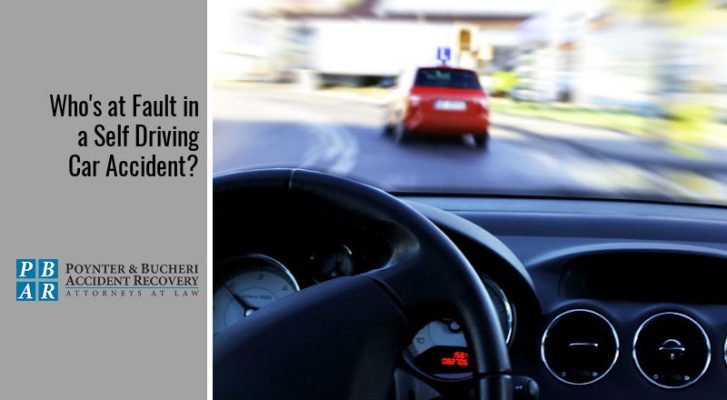
Who’s at Fault in a Self Driving Car Accident?

Self driving cars are steadily gaining in popularity. However, one primary concern with these vehicles is who is to blame when an accident occurs.
Traditionally, the negligent driver would be considered the at-fault party after a car accident. But with self driving cars, a negligent driver could blame their vehicle for causing the accident. And in some cases, it genuinely might have been a malfunction with the vehicle and not the driver that made the error.
So who’s at fault in a self driving car accident?
That’s what we are here to help you determine. There are multiple options for who could be held liable in a self driving car accident. But first, let’s examine why these specific cases are so challenging.
And if you have further questions after reading this article or need help with your Indiana car accident claim, don’t hesitate to reach out to the team at Poynter & Bucheri for assistance. We are here to help.
What Makes Self Driving Car Accident Cases So Challenging?
As self driving cars are still somewhat new, the issues that can arise are not entirely fleshed out. There is no set standard for self driving vehicles, which can make it difficult when an accident occurs.
Some of these primary issues with self driving cars include:
- A lack of “standard” regulated features: There are currently little to no rules or regulations governing the operation of self driving cars because there hasn’t been much need. However, as self driving cars gain in popularity, this is something that will need to be resolved.
For example, multiple companies are working on self driving cars, but this means there are various features and autonomous systems as well as a variety of terminology, rather than one standard system or standard terminology. This can lead to confusion in the event of an accident.
- Misuse of the term “autopilot” or “self driving”: While we call them self driving cars or autonomous vehicles, most of these cars are not fully autonomous. The various kinds of autopilot systems and features only allow for the vehicle to be partially in control. This means that human operation is still required.
For example, though a car might have a self parking or automatic lane adjustment feature, it is still the driver’s responsibility to pay attention and take over if and when they are needed. So, while the driver could try to blame their car for a mistake, it might still be their fault if they didn’t take over when needed, but determining how, when, or if they had needed to take over can be difficult after an accident happens.
- Automated systems are not perfect, nor are people: Though drivers are supposed to remain alert to take over if needed, it could genuinely be the car system that makes an error. And even if the driver takes over, it could be too late, and the damage could already be done. But in this case, is it the driver’s fault or the car manufacturer’s fault for designing a faulty system?
Causes of Self Driving Car Accidents
A self driving car accident can happen for the same reasons as any other car accident, such as speeding, distraction, driving while intoxicated, etc. However, there are some additional factors that could specifically result in an accident involving a self driving vehicle, such as:
- The vehicle failing to detect another car or even a pedestrian when making a move, such as while self parking
- A malfunction with autonomous steering resulting in the vehicle drifting into another lane
- Autonomous brake systems locking up
- Override errors with automatic acceleration
- The driver failing to pay attention and take over when necessary; in other words, an overreliance on the autopilot or autonomous features
- Other defective autonomous systems and features
Parties That Can Be Held Liable in a Self Driving Car Accident
So, who’s at fault in a self driving car accident?
While determining fault in a self driving car accident is more challenging, it’s not impossible and requires the same process as determining fault in any other kind of accident: gathering as much evidence as possible.
As the self driving cars that are available today are not fully autonomous and still require drivers to pay attention and step in when needed, fault will most likely still fall on the driver. However, it is possible for other parties to be held liable.
If the driver was paying attention and tried to take over, but the accident still occurred due to an error with the system, other potentially liable parties could include:
- The company that designed the self driving technology or the code that was used to create the vehicle
- The vehicle manufacturer
- The company that installed the self driving tech, if different from the manufacturer
Consult With an Indianapolis Self Driving Accident Lawyer
If you are injured in an accident involving a self driving car, you should consult with a self driving accident lawyer with experience handling these unique cases. There is a lot of legal grey area when it comes to self driving car accidents, but that doesn’t mean you shouldn’t still be able to get the compensation you deserve.
At Poynter & Bucheri, we will help you gather evidence to prove what happened and ensure the right party is held accountable, whether it’s the driver of the autonomous vehicle or a third party, such as the manufacturer. Don’t hesitate — an experienced Indiana personal injury lawyer can assist you right away. Call 1-800-265-9881 for a free case review.
